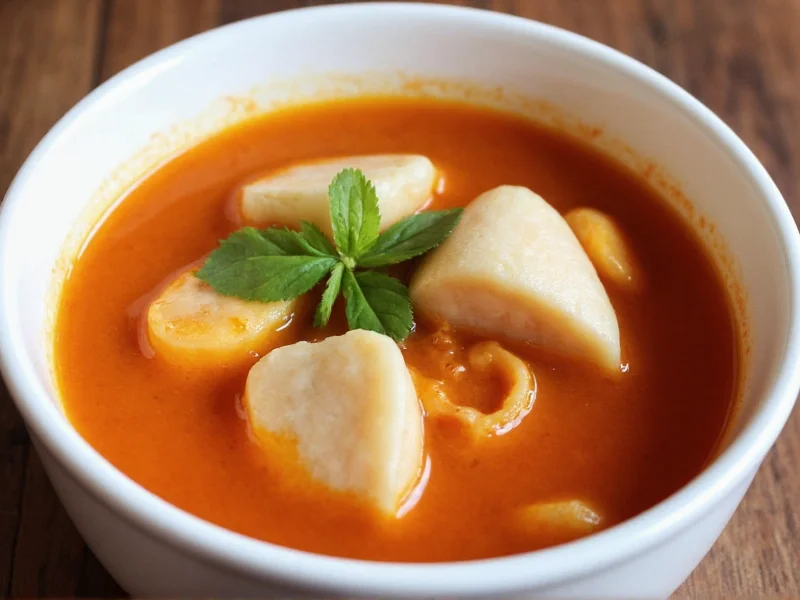Understanding Snapper Soup: Origins and Significance
Snapper soup has deep roots in coastal culinary traditions, particularly in Caribbean, Southern American, and Southeast Asian cuisines. The dish showcases red snapper fish, known for its firm texture and mild flavor that absorbs seasonings beautifully without overpowering the broth. Unlike chowders or bisques, authentic snapper soup maintains a clear, light consistency that highlights the freshness of the fish rather than masking it with heavy creams.
Nutritional Profile of Snapper Soup
When prepared traditionally, snapper soup delivers impressive health benefits. Red snapper provides high-quality protein, omega-3 fatty acids, and essential vitamins including B12 and D. The vegetable components contribute fiber, antioxidants, and various micronutrients. A standard serving (1 cup) of homemade snapper soup typically contains:
| Nutrient | Amount per Serving | Percentage of Daily Value |
|---|---|---|
| Calories | 180 | 9% |
| Protein | 22g | 44% |
| Omega-3 Fatty Acids | 1.2g | 75% |
| Vitamin B12 | 2.4mcg | 100% |
| Vitamin D | 150IU | 25% |
Essential Ingredients for Authentic Snapper Soup
Creating exceptional snapper soup requires attention to ingredient quality. The best homemade snapper soup starts with fresh or properly frozen snapper fillets. Look for firm, translucent flesh with no fishy odor. Key components include:
- Fresh snapper - 1.5 pounds, cut into 1.5-inch pieces
- Aromatic vegetables - onions, celery, bell peppers (the "holy trinity" of Southern cooking)
- Tomatoes - preferably San Marzano for their sweet acidity
- Fish stock - homemade yields best results
- Herbs - thyme, bay leaves, and parsley
- Citrus - lemon or lime juice for brightness
Step-by-Step Preparation Guide
Follow these steps for a perfect traditional snapper soup recipe with step-by-step instructions that ensure optimal flavor development:
- Prepare the base - Sauté onions, celery, and bell peppers in olive oil until translucent
- Add aromatics - Incorporate garlic, thyme, and bay leaves, cooking until fragrant
- Build the broth - Add tomatoes, fish stock, and bring to a gentle simmer
- Introduce the fish - Add snapper pieces and simmer for 8-10 minutes until just cooked through
- Finish with freshness - Stir in lemon juice and fresh parsley just before serving
Avoid overcooking the fish, which causes it to become tough and lose its delicate flavor. The entire preparation process for how to make snapper soup from scratch takes approximately 45 minutes.
Regional Variations and Adaptations
Authentic Caribbean snapper soup variations often include coconut milk for a creamy texture and Scotch bonnet peppers for heat. In Louisiana, you might find a version with a dark roux base, while Asian interpretations frequently incorporate ginger, lemongrass, and fish sauce. For those seeking gluten-free snapper soup options, simply omit any flour-based thickeners and rely on vegetable purees for body.
Serving Suggestions and Pairings
Snapper soup shines when served hot in pre-warmed bowls. Traditional accompaniments include:
- Crusty bread or cornbread for dipping
- Fresh salad with citrus vinaigrette
- White wine with crisp acidity like Sauvignon Blanc
The best ingredients for homemade snapper soup maintain the delicate balance between the fish's natural flavor and supporting elements. Avoid overpowering the snapper with too many competing flavors.
Storage and Reheating Guidelines
Proper snapper soup storage and reheating tips ensure optimal flavor preservation. Store in airtight containers in the refrigerator for up to 3 days. When reheating, warm gently over medium-low heat without boiling to prevent the fish from becoming tough. For longer storage, freeze without potatoes or other starchy vegetables (which can become mushy when thawed) for up to 3 months.
Troubleshooting Common Issues
Even experienced cooks encounter challenges with seafood soups. If your snapper soup turns out too fishy, you've likely used fish that wasn't fresh or overcooked the soup. Balance with additional acid (lemon juice) or aromatic vegetables. For a soup that's too thin, create a quick slurry with cornstarch and water. If it's too salty, add a peeled potato to absorb excess salt during reheating.
Frequently Asked Questions
Can I use frozen snapper for soup?
Yes, high-quality frozen snapper works well for soup. Thaw it overnight in the refrigerator before use. Properly frozen snapper maintains texture and flavor comparable to fresh fish, making it a practical option when fresh snapper isn't available.
How do I prevent the fish from overcooking in soup?
Add the fish during the final 8-10 minutes of cooking. The residual heat continues to cook the fish after removal from heat. For best results, cut fish into uniform pieces and maintain a gentle simmer rather than a rolling boil.
What's the difference between snapper soup and fish chowder?
Snapper soup features a clear, light broth that highlights the delicate flavor of the fish, while chowder is typically thickened with cream or roux and contains potatoes and other hearty vegetables. Snapper soup generally has a more refined texture and emphasizes the primary seafood ingredient.
Can I make snapper soup in advance?
Yes, but add the fish just before serving. Prepare the broth base up to two days ahead, then add fresh fish when reheating. This preserves the delicate texture of the snapper and prevents it from becoming tough during storage.
What are good substitutes if I can't find red snapper?
Grouper, sea bass, or halibut make excellent substitutes with similar firm texture and mild flavor. Avoid strongly flavored fish like mackerel or salmon, which would overpower the delicate balance of traditional snapper soup.











 浙公网安备
33010002000092号
浙公网安备
33010002000092号 浙B2-20120091-4
浙B2-20120091-4